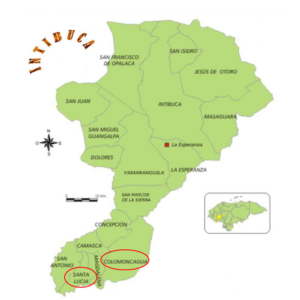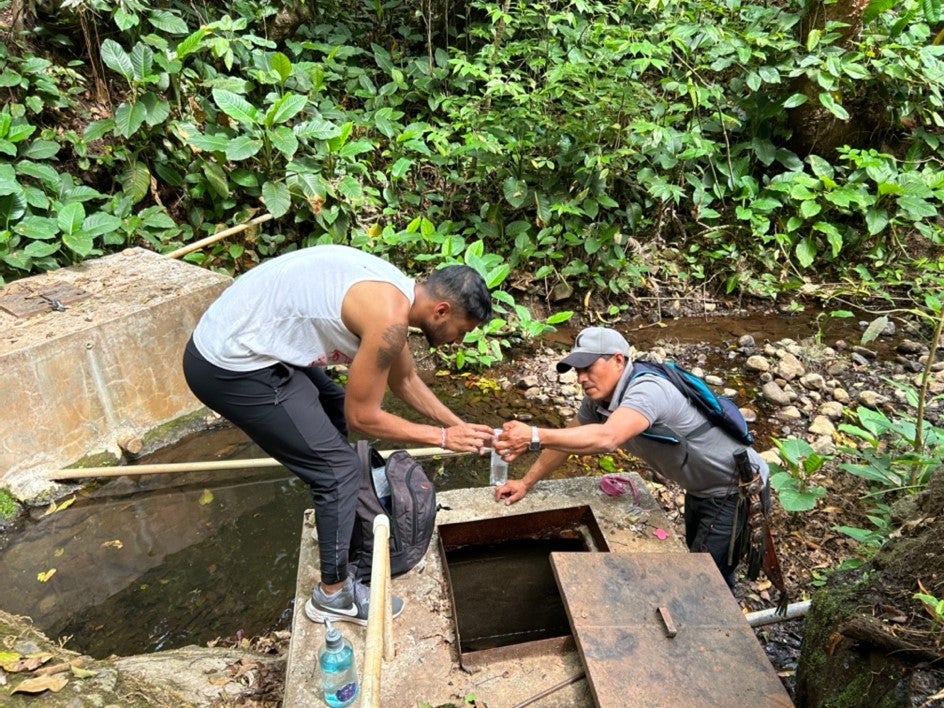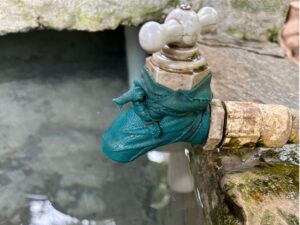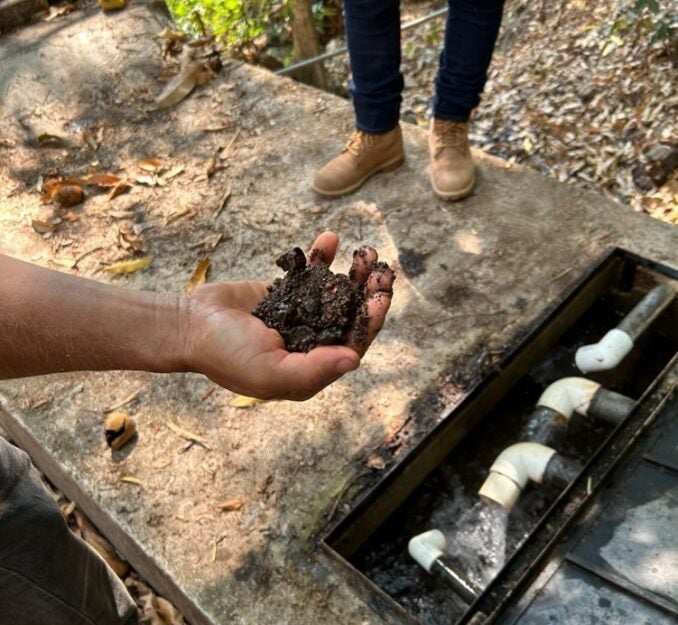Pictured above: Local volunteer holds sediment at risk of contaminating spring water collection site in Santa Lucia, Honduras.
By Nava Barman
Rose Service Learning Fellow
MPH Candidate, Global Health
Background
When I visited Intibucá, Honduras for the first time as an undergraduate in 2017, I was struck by its similarity to my family’s hometown in Northeast India. Tucked away in the mountains away from any major city, life is more tranquil. Like my hometown, a walk down the local road catches familiar sights of streetside produce markets and three-wheeled moto-taxis. Perhaps this familiarity, this feeling of being “at home”, is part of why I decided to return to Honduras after so many years through the Rose Service-Learning Fellowship.
When I was accepted to this MPH program, I knew my plan for my practicum would be to return to Honduras. I reached out to Shoulder to Shoulder, the local NGO with whom I partnered before, and spoke to the director and local staff about what I could help with. As a medical student interested in pediatrics and child neurology, I thought I could work directly in one of these areas. However, as we spoke more, it became obvious that one area remained chronically underserved and understudied: potable drinking water. I was told, “Children continue to suffer from diarrhea here, especially during the rainy season. Might this be related to the local water system?”
Their question was multi-faceted and broad. But as I slowly understood the complexity of the issue, I struggled with my own question: “Where do I begin?”. With minimal experience in water and sanitation/hygiene (WASH) fieldwork, I began meeting with experts for advice. In a meeting with WASH-expert Dr. Richard Cash, I realized I did not have the answer to several fundamental questions he posed. These were:
- Where does the water come from?
- How is the water stored? How is it distributed?
- Who is drinking the water?
- Does the water undergo regular testing and purification?
- Are there opportunities for contamination between the source and the point of consumption?
In another meeting with Dr. Chris Duggan, an expert on enteric disease among children, we discussed how health-seeking behaviors in cases of diarrhea could be examined.
- How long do parents wait to consult a physician when the child has diarrhea?
- What “red flags” do parents look for when children have diarrhea?
- How do local clinicians respond to both common and severe cases of diarrhea?
I was beginning to assemble a team of advisers for this project, and as my knowledge about the field grew, so did my confidence. Luckily, Shoulder to Shoulder already had an ongoing research project in water quality with the University of Georgia Southern. Seeing that my project goals aligned well, these outside investigators became important collaborators and mentors for my fieldwork.
On The Ground
The purpose of my practicum was to provide a needs-assessment in water quality issues in the southern border of Honduras, nicknamed “La Frontera”. My job was to visit two counties in this area, Santa Lucia and Colomoncagua, each with a “town center” surrounded by several small villages or “aldeas”. My needs-assessment included two components — 1) field testing of local water sources, storage tanks, and faucets for E. coli and 2) interviews with folks in their homes and at schools to understand how water is treated and consumed, especially for children under 5 years of age.

There was a common rhythm I found to obtain the water samples. An NGO staff would introduce me to a local schoolteacher or clinician, who would then introduce me to a “junta de agua”—or local water administrator. These volunteers were in charge of the public water project, from cleaning pipes to water distribution. In each community, I would hike up the mountain with these men to collect my samples. Along the way, I would learn about their lives and their community. Some had lived in the United States as unofficial immigrants, and enjoyed that they could practice their English with me. Some were farmers and field-hands, serving the community with accessible produce and meat that otherwise would be far too expensive to purchase. One of these farmers famously recorded his activities on his own YouTube channel, and made enough of a following that the earnings could pay for his living expenses. Each “junta de agua” had such a unique story and personality. Getting to know them became treasured moments for me.

With the help of the juntas de agua, I collected over 20 samples of water from 8 different communities. My water tests, developed by Aquagenx, were practical for the field – they required only 48 hours to give a visual result and did not require any lab or equipment. The first few results came out positive in under 36 hours. Within the first week, over 90% of samples tested positive for E. coli, and I had to reckon with how I would share these results with the community.
I grappled with the emotional difficulty of delivering negative news without immediate solutions. It was common knowledge that water from the tap is not great to drink, but now we were presented with visual evidence of a dangerous bacteria found in almost all the water. As I tried to explain the results, initial reactions from community members were of anxiousness and confusion. As a researcher without immediately tangible solutions, I wondered if it was better for me to avoid these conversations altogether and allow the NGO to handle it. Luckily, I was able to discuss my concerns with my collaborators, some of whom were from the communities themselves. The local staff were adamant that if bacteria was found in their water, they had a right to know the results immediately. Hearing that, I was re-affirmed that being transparent in my results would be in the best interest of the community.

Qualitatively, my interviews with families and schoolteachers also helped me understand that “water and hygiene practices” goes beyond knowing the facts. Each family was used to certain behaviors and habits, some that were cultural to the region and others that were necessary due to lack of resources. In Santa Lucia, many families and schools actively used small amounts of chlorine to disinfect their water. In Colomoncagua, which is noticeably less resourced, families could not afford chlorine and believed “cloth filters” and disinfection by sunlight were equally effective. Neither community was wrong, and each believed “doing something was better than nothing. Simply put, they had to “work with what they got”. I learned a great deal from these conversations, illuminating why people do what they do with their water.
Final thoughts
As I wrap up my 2-week excursion and prepare my findings, I feel pleasantly reassured. This was my third time doing global health work in Honduras, but the first time that I felt my work was in tune with the intentions and momentum of the local community. I was led to the water by the community leaders, learned about the issue from locals, and am preparing my final report in Spanish so that they can all access it. This has become my first principle in conducting global health fieldwork: You have much to gain by acting at the request of your partners rather than from your own personal ambition. As Shoulder to Shoulder and I collaborate on next steps, I’m thrilled that through this Rose Service-Learning Fellowship I could deliver something of value to the people of La Frontera – a place near and dear to my heart.

You must be logged in to post a comment.